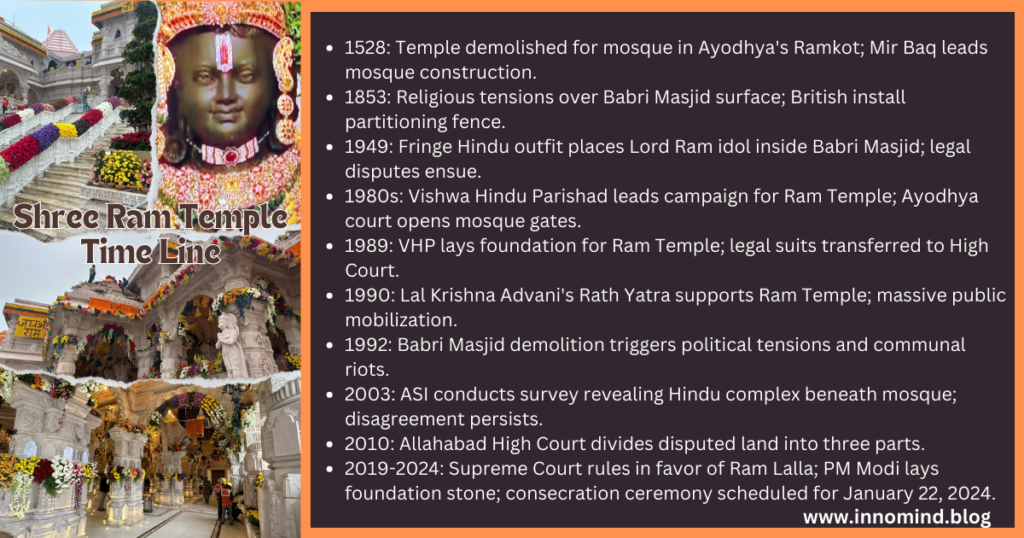An important event is set to take place on January 22, 2024, in the heart of Ayodhya, a city steeped in antiquity and revered as the birthplace of Lord Ram. The ‘Pran Pratishtha’ ceremony will mark the consecration of the grand Ram Mandir. Led by Prime Minister Narendra Modi, it will bring the culmination of the age-old narrative that has woven itself into the cultural and spiritual tapestry of Ayodhya. This article travels through time, exploring the history that led to the construction of the Ram Temple and important milestones along the way.
Historical background:
The story of Ram Temple is deeply linked to the rich history of Ayodhya, a city that holds immense spiritual, historical and cultural significance. The story begins in 1528 when a temple at the alleged birthplace of Lord Rama was demolished to build a mosque during the reign of Mughal ruler Babur. This incident set the stage for centuries of religious and legal disputes over the disputed site.

Timeline of major events:
- 1853: Tension erupted at the Babri Masjid site, leading the British administration to erect a dividing fence after six years. The precincts allowed Muslims to pray within the mosque, while the outer court was designated for Hindu use.
- 1949: Members of a Hindu organization placed the idol of Lord Ram inside the Babri Masjid, leading to legal and communal tension. Petitions were filed by both Hindu and Muslim groups, and the government intervened by closing the complex but allowing daily worship.
- 1980s: The Ram temple construction campaign gained momentum under the leadership of Vishwa Hindu Parishad (VHP). In 1986, the Ayodhya court ordered the opening of the mosque’s doors for Hindu worship, following which the Muslim community formed the ‘Babri Masjid Action Committee’.
- 1989: The foundation stone of Ram temple was laid by VHP on the adjacent land. Legal complications arose and the case was transferred to a special bench of the High Court.
- 1990: Lal Krishna Advani’s Rath Yatra expressing support for the Ram Mandir movement proved to be a significant moment. This mass mobilization increased tension throughout the country.
- 1992: The demolition of the Babri Masjid by Kar Sevaks was a seismic event, resulting in political tensions and communal riots that claimed at least 2,000 lives.
- 2003: The Archaeological Survey of India (ASI) surveyed the disputed site, uncovering evidence of a large Hindu complex beneath the mosque.
- 2010: Allahabad High Court divided the disputed land into three parts and allotted some parts to Ram Lalla, Islamic Waqf Board and Nirmohi Akhara.
- 2019: The Supreme Court delivered a historic verdict, ruling in favour of Ram Lalla and handing over the responsibility of overseeing the construction of the Ram Temple to a trust.
- 2020: Prime Minister Narendra Modi laid the foundation stone of the Ram Temple on August 5, 2020, marking the beginning of the construction project.
- 2024: The Pran Pratistha ceremony is scheduled to consecrate the idol of Ram Lalla on January 22, 2024, culminating in a grand celebration attended by dignitaries, devotees and representatives of various communities.
Life consecration ceremony:
The Pran Pratishtha ceremony held on January 22, 2024 marked the consecration of the idol of Ram Lala in the newly constructed Ram temple. Prime Minister Narendra Modi participated in the event along with many eminent personalities. The sculptor behind the statue, Arun Yogiraj, who hails from a lineage of renowned sculptors, expressed his gratitude and considered himself “the luckiest man on earth”.
The 4.24 feet tall idol depicts Lord Rama as a five-year-old child, standing on a lotus, which is carved from the same stone. The ceremony was attended by representatives of spiritual and religious sects, tribal communities and prominent personalities. The consecration ceremony symbolizes the spiritual and cultural importance of the Ram temple, further cementing Ayodhya’s place in the history of India.
Arun Yogiraj’s journey:
Arun Yogiraj, the sculptor of the Ram Lalla statue, hails from a distinguished lineage of sculptors from Mysuru, Karnataka. Despite pursuing an MBA and working in the corporate sector for some time, Yogiraj’s passion for sculpture drew him back to the art form in 2008. Since then, his artistry has evolved, creating iconic sculptures that have gained recognition across the country. Yogiraj’s portfolio includes a 30-foot statue of Subhash Chandra Bose, which is prominently displayed near the India Gate in New Delhi.
The consecration of the idol of Ram Lalla in the Ram temple in Ayodhya is a historic moment that concludes a centuries-long saga. The Pran Pratistha ceremony not only marks the conclusion of the long-running dispute but also adds a new chapter to the cultural and spiritual heritage of Ayodhya. As the Ram Temple stands, it is a symbol of faith, resilience and devotion – a testament to the enduring spirit of those who contributed to its construction and the millions who revere Lord Rama.
